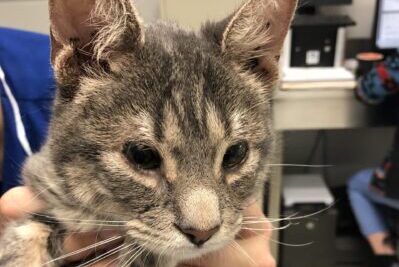Understanding Feline Diabetes

Understanding Feline Diabetes
According to the American Diabetes Association, November is American Diabetes Month. Due to obesity, diabetes is on the rise in people and, unfortunately, the same is true for our feline companions. The theme for American Diabetes Month 2012 is “A Day in the Life of Diabetes” and I will detail some of the daily routine of a diabetic cat and his owner, me.
Symba was the cat who came to me shortly after I graduated from veterinary school. He became acutely ill while I was traveling, and my colleagues at The Animal Medical Center diagnosed him with pancreatitis and diabetes. Pancreatitis, inflammation of the pancreas, destroys the ability of that organ to make insulin, and without insulin the result is diabetes. Recurrent pancreatitis and obesity commonly play a role in feline diabetes.
Giving insulin
When Symba came home from the hospital, I had to give insulin injections twice a day. Easy for me, but an aspect of managing diabetes most families with a newly diagnosed diabetic cat initially worry about. In a recent international survey on the quality of life for cats with diabetes, 221 cat owners reported few difficulties in administering insulin, but they did not like adhering to the required rigid schedule of injections.
Twice daily insulin administration gives your cat the best chance of achieving remission of diabetes. Remission means no more insulin injections – good for you and your cat. Twice daily insulin injections did work for Symba. He went into remission which lasted over a year.
Scary hypoglycemia
The feline diabetes quality of life survey found cat owners worried about hypoglycemia, also known as low blood sugar. Low blood sugar deprives critical organs of the sugar they need for fuel. Early signs of hypoglycemia include muscle tremors, lethargy, weakness, and staggering. A seizure or coma means the blood sugar is seriously low and a trip to the animal ER is necessary.
Monitoring blood sugar levels or urine sugar levels will help your cat avoid a hypoglycemic crisis. At the first signs of hypoglycemia, feeding a meal may avert a crisis. Although cat owners involved in the quality of life study worried about hypoglycemia, in actuality it rarely happened. When Symba developed hypoglycemia, I gave him the corn syrup I had in the kitchen cabinet just for this purpose. Maple syrup or honey work too. The good thing about a hypoglycemic crisis is it may mean your cat requires less insulin and might be going into diabetic remission.
Boarding barrier
When I traveled, my colleagues at The AMC took care of Symba at the hospital, but the feline diabetes quality of life participants ranked finding a friend, family member, or boarding facility to take care of their diabetic cat one of their major challenges. Advance planning will help remove some of the stress associated with leaving your cat behind while you travel.
Good quality of life
Despite the challenges to cat and owner, 94% of cat owners rated their diabetic cat’s life as good, fairly good or as good as it could be. When asked if they would treat another cat for diabetes, a resounding 90% said yes.
Prevent diabetes in your cat by keeping her in ideal body condition. Control food intake and provide opportunities to exercise.
To help support diabetes research, CVS pharmacies are donating one dollar for every photo depicting a day in the life of diabetes that is posted on the American Diabetes Association Facebook page.
So start uploading!


































